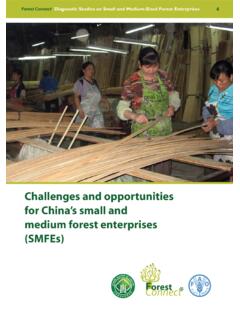Transcription of Small and medium-sized enterprises and decent and ...
1 International Labour Conference, 104th Session, 2015 Report IV Small and medium - sized enterprises and decent and productive employment creation Fourth item on the agenda International Labour Office, Geneva ISBN 978-92-2-129011-7 (print) ISBN 978-92-2-129012-4 (Web pdf) ISSN 0074-6681 First edition 2015 The designations employed in ILO publications, which are in conformity with United Nations practice, and the presentation of material therein do not imply the expression of any opinion whatsoever on the part of the International Labour Office concerning the legal status of any country, area or territory or of its authorities, or concerning the delimitation of its frontiers. Reference to names of firms and commercial products and processes does not imply their endorsement by the International Labour Office, and any failure to mention a particular firm, commercial product or process is not a sign of disapproval.
2 ILO publications can be obtained through major booksellers or ILO local offices in many countries, or direct from ILO Publications, International Labour Office, CH-1211 Geneva 22, Switzerland. Catalogues or lists of new publications are available free of charge from the above address, or by email: Visit our website: Formatted by TTE: Confrep-ILC104(2015)-IV[ENTER-150121-1] Printed by the International Labour Office, Geneva, Switzerland iii Contents Page Executive summary .. v Are SMEs a major job creation engine? .. v What are key constraints faced by SMEs and their workers? .. vi What SME policies do work? .. vi Validity of earlier ILO Recommendations, synergies with other ILC discussions, and alignment with new ILO priorities .. viii Chapter 1. Introduction .. 1 Context .. 1 Structure of the report.
3 1 Definitions .. 2 Chapter 2. Contribution of SMEs to employment and economic growth .. 3 Contribution of SMEs to employment .. 3 Number of SMEs in the total enterprise population, in the informal economy, and those owned by women .. 5 Enterprise size and job creation .. 6 Relative contribution of young enterprises , start-ups and gazelles .. 9 and wage income .. 12 Contribution to national income and economic 15 Summing up .. 16 Chapter 3. Constraints faced by SMEs and their workers .. 19 Constraints faced by enterprises .. 19 Problems and disadvantages faced by workers in SMEs .. 21 Chapter 4. SME policies: Definition, rationale and linkages with other policy areas .. 27 Definition and objectives .. 27 Rationale .. 28 Linkages with other key policy areas .. 29 Small and medium - sized enterprises and decent and productive employment creation iv Page Chapter 5.
4 Relevance and effectiveness of SME policies in supporting ILO priorities .. 31 Introduction .. 31 Access to finance and entrepreneurship training .. 32 Enabling 38 Formalization of informal SMEs .. 44 Promoting improved working conditions and SME productivity .. 50 Value chain development .. 56 New trends in SME policies .. 58 Chapter 6. Suggested points for discussion .. 67 Appendix Overview of findings for interventions using ILO products for entrepreneurship training and access to finance .. 69 v Executive summary The purpose of this report is to provide delegates to the 104th Session of the International Labour Conference with up-to-date evidence on the relevance of Small and medium - sized enterprises (SMEs) for employment, the key constraints faced by SMEs and their workers, and the effectiveness of measures to support this enterprise segment.
5 The report ultimately attempts to provide answers to crucial questions such as whether SMEs are living up to their promise of being a major contributor to job creation, whether these jobs are of adequate quality, and how effective the various policies for promoting SMEs are. Are SMEs a major job creation engine? There is solid empirical evidence confirming that SMEs are a major job creation engine. However, the analysis also clearly shows that the sector is very diverse. This is a serious obstacle to policy formulation for this enterprise size class as a whole. There is a risk that promoting SMEs because of their large contribution to employment, without further differentiating them by sub-segments, may result in a trade-off between the quantity and quality of employment, because SMEs also include a large number of micro- enterprises that create jobs that are neither productive nor decent .
6 Moreover, the data presented from developed countries show that entrepreneurial activities and the corresponding employment creation are more closely related to the age of the enterprises than to their size per se. It is especially young Small enterprises that make disproportionally high contributions to employment. Even within SMEs in the large informal economy in developing countries, the same heterogeneity, and hence the same need for policy differentiation, can be found. In contrast to the prevailing view that the informal enterprise segment consists only of subsistence entrepreneurs, there is in fact a sizeable higher tier of growth-oriented informal enterprises that can make significant contributions to employment generation. Nevertheless, it is important to note that most SMEs in developing countries are low-productivity informal micro- enterprises that will not grow and create additional jobs.
7 A key consequence for policy-making is that policies for SMEs need to be based on a better differentiation between the heterogeneous parts of the size group. Specific measures should be considered for young, growing enterprises , alongside evaluations of whether the expected positive quantitative and qualitative effects on employment are achieved. At the same time, support for micro- enterprises should be continued, since they play an important role in providing incomes and livelihoods, especially where there is a lack of sufficient wage employment. Small and medium - sized enterprises and decent and productive employment creation vi What are key constraints faced by SMEs and their workers? The constraints to SME growth as perceived by business owners is a relatively well-researched area.
8 The three biggest constraints across countries are access to finance, access to electricity and competition from informal enterprises . However, constraints vary according to countries level of development as well as by region. There is a need to continuously update this information through representative enterprise surveys, as has been done by the ILO and others, in order to maintain and expand the foundation for an evidence-based policy dialogue. Much less is known about the problems or disadvantages that are faced by workers in SMEs. The only solid data come from the European Union (EU), and they show that SMEs generally score lower than large enterprises in indicators of the quality of employment. No data are available for low- and middle-income countries. This situation has three implications. First, it highlights the need for more data to be collected on the quality of employment in SMEs.
9 Second, the available findings that the quality of employment is lower in SMEs should not lead to an abandonment of SME promotion; their contribution to job creation is too important. Instead, the objective should be to support SMEs in increasing their productivity and improving the quality of jobs. With that in mind, the ILO has made productivity and working conditions in SMEs one of its new areas of critical importance. Third, an important finding from the available data is that the economic sector in which an SME operates has a stronger influence on the quality of employment than the size of the enterprise. It might thus be more effective to focus on specific sectors rather than on enterprise size segments when designing future interventions to improve the quality of employment.
10 Employers and workers organizations can play an important part in helping SMEs and their workers to overcome the constraints that they face. Increasing the representation of SMEs in both types of organization will help to further strengthen their role as advocates for this enterprise segment. Social partners also provide a variety of important services to their members that can be beneficial for SMEs. These services include information, training, guidance on how to access public and private business support services, links to research and consultancy resources, business matchmaking and advice on responsible workplace practices. Employers organizations should continue to periodically assess the enabling environment through enterprise surveys, business barometers and other tools.



















